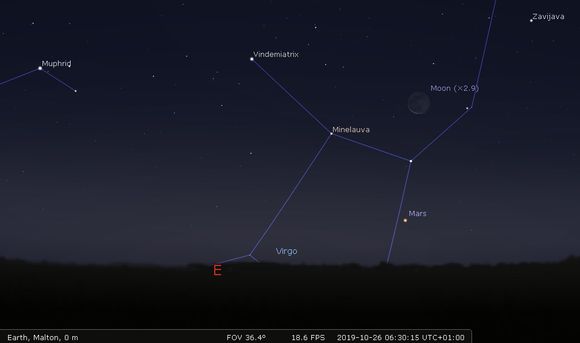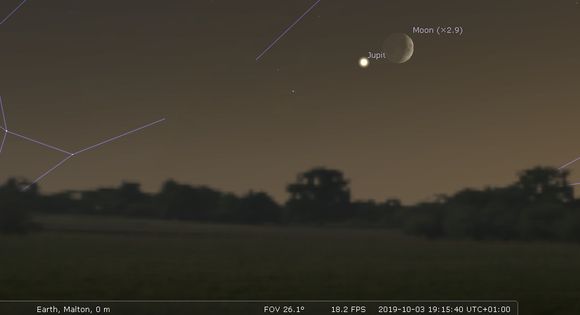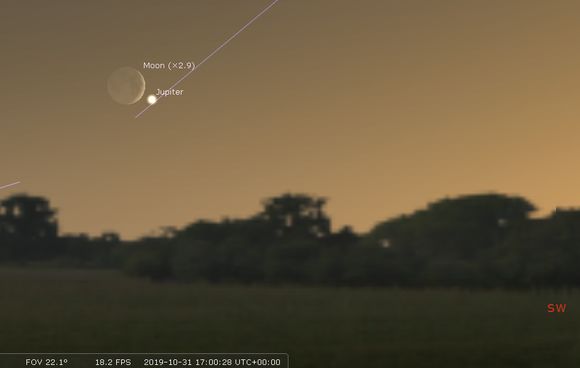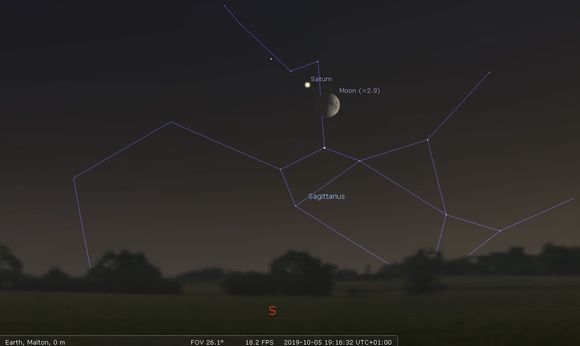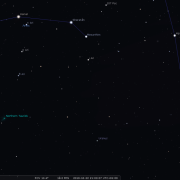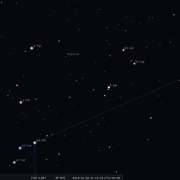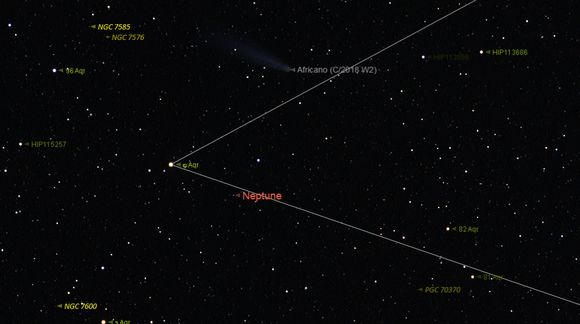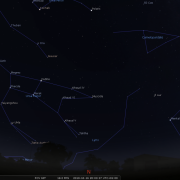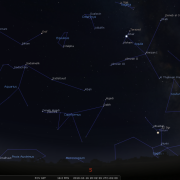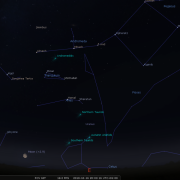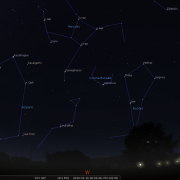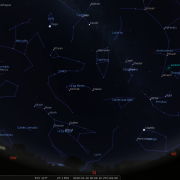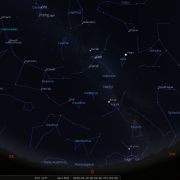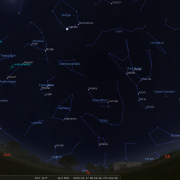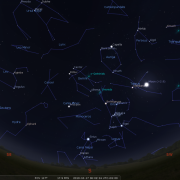In this month's Sky Notes:
Planetary Skylights
Jupiter and Saturn remain the most conspicuous evening planets visible, although Neptune and Uranus may be tracked down in the evening sky, but you will probably require a telescope.

 Mars and Venus may be glimpsed with the naked eye, but are not viable telescopic targets this month.
Mars and Venus may be glimpsed with the naked eye, but are not viable telescopic targets this month.

 Jupiter lingers very low in the southwest twilight sky, but will be setting within an hour of the sun by the month’s end. Look for it on the 3rd and again on the 31st when a young crescent moon resides close to Jupiter.
Jupiter lingers very low in the southwest twilight sky, but will be setting within an hour of the sun by the month’s end. Look for it on the 3rd and again on the 31st when a young crescent moon resides close to Jupiter.
Crescent Moon and Jupiter. (Top: 03-Oct-2019 at 19:15h: Bottom: 31-Oct-2019 at 17:00h)
(Click for full-sized images)
 Of lesser prominence (compared to Jupiter) is Saturn, resembling a fairly bright star low in the SSW as dusk falls. It too is gradually edging toward the SW, sitting just to the left of the ‘teapot’ asterism in Sagittarius. If you can observe with a telescope, do so early in the month when Saturn is at least a reasonable distance above the horizon. Wait for those steady ‘seeing’ moments to appreciate the ring system which remains well orientated. Look also for a few of Saturn’s moons, most notably Titan, seen as a bright speck nearby. A waxing crescent moon lies nearby Saturn on the 5th.
Of lesser prominence (compared to Jupiter) is Saturn, resembling a fairly bright star low in the SSW as dusk falls. It too is gradually edging toward the SW, sitting just to the left of the ‘teapot’ asterism in Sagittarius. If you can observe with a telescope, do so early in the month when Saturn is at least a reasonable distance above the horizon. Wait for those steady ‘seeing’ moments to appreciate the ring system which remains well orientated. Look also for a few of Saturn’s moons, most notably Titan, seen as a bright speck nearby. A waxing crescent moon lies nearby Saturn on the 5th.
 Towards the end of the month Uranus becomes the last of the gas giant planets to reach opposition this year. Although not a naked eye object for the majority of people, keen sighted observers viewing from a dark location may be able to spot it (assuming they know exactly where to look). Uranus resides just within the borders of Aries, but is some distance below the ‘crooked line’ asterism of the Ram. If you have a constellation chart or App etc, use Mesarthim and iota Aries as pointers to locate Uranus, which resides 3 times the distance between these stars, below them. Aries is located due east around 20:00h mid October. Through binoculars Uranus resembles a rather faint star of subtle grey/green hue. You will require a telescope to discern its tiny disk.
Towards the end of the month Uranus becomes the last of the gas giant planets to reach opposition this year. Although not a naked eye object for the majority of people, keen sighted observers viewing from a dark location may be able to spot it (assuming they know exactly where to look). Uranus resides just within the borders of Aries, but is some distance below the ‘crooked line’ asterism of the Ram. If you have a constellation chart or App etc, use Mesarthim and iota Aries as pointers to locate Uranus, which resides 3 times the distance between these stars, below them. Aries is located due east around 20:00h mid October. Through binoculars Uranus resembles a rather faint star of subtle grey/green hue. You will require a telescope to discern its tiny disk.
 Neptune reached opposition last month residing in the constellation of Aquarius close by the star Phi aqr. You will require a telescope to spot its diminutive disk, which is fainter than all visible naked eye stars, but it does appear decidedly blue grey in hue. It is now moving away from Phi aqr.
Neptune reached opposition last month residing in the constellation of Aquarius close by the star Phi aqr. You will require a telescope to spot its diminutive disk, which is fainter than all visible naked eye stars, but it does appear decidedly blue grey in hue. It is now moving away from Phi aqr.
Meteors

- The Orionids (Oct 16- 27) are the month’s most reliable shower, peaking this year on Oct 21/22. Prospects are better than last year, as the moon will be at last quarter, but there will still be interference from moonlight. The peak rate of 20-25 will be reduced a little to perhaps a dozen. Like the May Eta Aquarids, Orionids are associated with Comet Halley, but are more favourable for northern hemisphere observers due to the radiant being situated high in the South by early morning hours. Orionids are swift moving, often producing persistent trains.
- The Southern Taurids peak on the 10th, however rates will be little more than sporadic levels (5 per hour) and a gibbous moon will drown out all but the brightest.
- The weak Piscid shower has three peak dates, Oct 13th being the optimum, however this is a full moon date, so few will be witnessed. Observed rates are little better than sporadic levels - around 3-7 per hour. Piscid meteors are often slow, of long duration, but not very brilliant.
- Perhaps the most interesting shower is the Giacobinids or Draconids (Oct 6 -10th peaking on the 8th) which are associated with the periodic comet Giacabini-Zinner (6yrs) The shower is very erratic, but can produce outbursts of activity. This year evidence from the BAA and IMO again suggests that this may be the case. Observing over the night of the 8th, rates exceeding 25 per hour are possible in the early morning hours and with no moonlight present an observer is likely to see at least a dozen. The Draconids; associated with the constellation of Draco, which is located high up in the NW winding its way between the two celestial bears of Ursa Major and Minor.
Comet 2018 W2 (Africano)
Although not a naked eye object, W2 is still well placed in the evening sky for northern hemisphere observers. Around mag +9.8 it is visible in 10X50 or above binoculars or a telescope. The comet was closest to Earth on Sept 27th and is now moving rapidly southward through Pegasus, Pisces, and into Aquarius before slowing in to Piscis Austrinus by mid-October. The comet is then expected to fade. It passes by Neptune on the 3rd Oct. More detailed charts will be shown at the October meeting on the 1st.
October 2019 Sky Charts
|
Looking North
Mid-October - 20:00h |
Looking South |
|
Looking East
Mid-October - 20:00h |
Looking West
Mid-October - 20:00h |
|
Northern Aspect
Mid-October - 20:00h |
Southern Aspect
Mid-October - 20:00h |
| Looking North (Early) Mid-October - 06:00h |
Looking South (Early) Mid-October - 06:00h |
Additional Image Credits:
- Planets and Comets where not otherwise mentioned: NASA
- Sky Charts: Stellarium Software
- Log in to post comments

